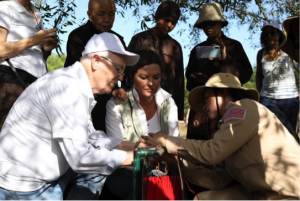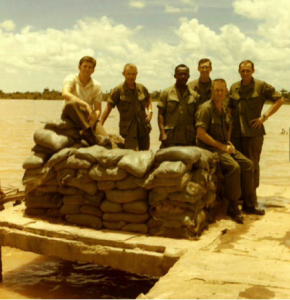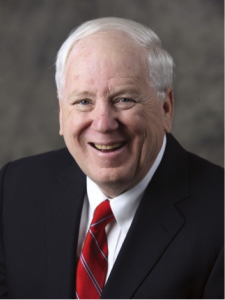by Kenneth M. Quinn
As the country is convulsed by the simultaneous nationwide Black Lives Matter protests over racism and the devastation of more than 150,000 Coronavirus deaths, I sought escape in Spike Lee’s latest offering on Netflix— “Da 5 Bloods,” a story of four African American army veterans returning to Vietnam 50 years after their wartime service. They are drawn back together to return to their former battlefield to search for the remains of their Black comrade—the fifth Blood—who died in combat but whose body was not recovered.
Like the four Bloods, I too had just this past January returned to Vietnam where I had my first tour as a State Department Foreign Service Officer in 1968. Like them, I traveled to the now quiet battlefield of Khe Sahn and other heavily bombed areas of the country, which are still beset with thousands of land mines and unexploded ordinance. I was there as part of a Roots of Peace delegation supporting efforts to eradicate these silent killers that are still taking lives 25 years after our two countries re-established diplomatic relations.

As the film begins, the four friends are sitting together in the Apocalypse Now night club in Ho Chi Minh City, reflecting on the injustice of the vastly over-representative Black participation in, and Black deaths during, the war. Interspersing clips of Dr. Martin Luther King and Muhammad Ali speaking against the war in the 1960s, Director Lee outlines an array of complex issues about what was happening in America that formed the backdrop to the Black experience in that wildly unpopular conflict.
Those clips took me back to Washington D.C. in 1968 where I was learning Vietnamese, and had a front row seat to the political and racial upheaval wrought by the successive political earthquakes of the Tet offensive, the assassination of Dr. Martin Luther King Jr. and the shooting of Senator Robert F. Kennedy. I vividly recalled being stunned by the scene of Washington ablaze in protest over the murder of Dr. King, as an intense racial polarization beset the Capital and the country.
In the movie, this racial division is reflected in the conversation among the four friends. The actor Delroy Lindo gives a riveting performance as the MAGA hat-wearing Paul, dominating the exchange as he reflects the multiplicity of issues that affect all Black Vietnam vets. In the signature moment of the film, the character Melvin, played by Isiah Whitlock Jr., leans in and speaks the sentence that explains why they were back together five decades later. Clearly intending to convey that Black bond forged in combat, Melvin says: “We became blood brothers out in that damned jungle.”
As I watched Da 5 Bloods, I experienced a flood of memories from my own six years service in Vietnam during the war. What I didn’t anticipate was that the film would make me recall the greatest lesson of my initial diplomatic assignment—witnessing race dissolve and at times disappear between Americans.
It was here that I paused the film. I wanted to argue with Spike Lee. For what I saw during my deployment in the jungles of the Mekong Delta in 1969-70 was the bond that linked all Americans—Black and white—together in combat. What ultimately overcame the racial divide was the commitment to each other for protection and survival.
My initial assignment as a brand new diplomat was not to Paris or Vienna, as I had naively requested, but to Vietnam. And not to the embassy in Saigon, but the Military Assistance Command’s Civil Operations and Revolutionary Development Support (CORDS) provincial pacification program. (The name was later changed to Civil Operations and Rural Development Support.) Specifically, I was to be a rural development advisor working in villages as part of MACV / CORDS Advisory Team 65 in Sa Dec Province in the Mekong Delta.
Eventually, I was named a District Senior Advisor heading a 10-man U.S. military advisory team. Replacing an army major, this position had me—a State Department officer—regularly taking part in military operations accompanying South Vietnamese troops on extended forays walking into Viet Cong base areas. In addition, almost every evening I climbed into a U.S. Army Huey helicopter to fly low over enemy areas searching for and attacking any concentration of North Vietnamese troops that might be gathering for a night attack. By participating in over 200 hours of helicopter combat missions, I became the only civilian to be awarded the Army Air Medal in the Vietnam war, and almost certainly the only Foreign Service Officer ever so recognized.

It was during those many military operations that I saw first hand that bond that united us. When you heard on the military radio that Uniform Sierras (the military-speak term for U.S. personnel) were under fire or in need of assistance, you responded. You didn’t ask their race, ethnicity, or religion. It didn’t matter whether you knew them or not. All you needed to know was that they were fellow Americans. No matter the danger, you went to save them because you knew that they would do the same for you.
I saw that bond one night when several African American infantrymen were separated from their unit during a Viet Cong ambush in my district. Alone in the jungle in the midst of an enemy force, their voices on the radio reflected that they were in desperate need of help. It was then that a white helicopter pilot, whom I knew from our operating together, came on the radio. Flying perilously low over the Viet Cong-infested area, the pilot directed the U.S. troops on the ground to an area where, ignoring the immense threat to his aircraft, he was able to land, pick them up, and fly to safety.
I had a similar experience when accompanying Vietnamese troops on a ground operation across water-logged rice paddies and into thick mangrove swamps deep in an enemy base area. Moving through that jungle environment was particularly exhausting as for hours we climbed up and down an unending string of embankments and in and out of stagnant pools of Mekong River overflow. It was then that I became separated from our unit.
Alone, as dark was falling, I was stranded in waist-deep water with the possibility that the enemy could be hiding behind the thick vegetation only a few feet away. It was then that a large Black hand appeared above me, as if descending from heaven. It was Sgt. Bobby Chase from our advisory team. Reflecting that bond that linked us as Americans, he had taken the risk to come back to find me and extricate me from danger.
Although it may not have been present back in base camps—where racial divisions reflecting those back home often prevailed—in the jungle or when under enemy fire, the bond of being an American came to the fore. And while no one would have explained it that way, we in fact all became brothers out in that damned jungle.
As Spike Lee’s movie progressed, it seemed to me that this same theme of Black and white linkage began subtly to emerge. The four Bloods make their way out into the stark Vietnamese countryside, still beset with buried land mines, in search of the remains of the “fifth Blood,” as well as (spoiler alert) a treasure of CIA gold bars they had discovered and buried during that battle 50 years earlier. Since there are still thousands and thousands of land mines and unexploded bombs buried on former battlefields, the Bloods encounter a group of white de-mining experts.
 When one of the Blood Brothers inadvertently steps on the pressure plate of a hidden land mine, the only hope of saving him from being blown up takes all of the other Bloods and the three white de-miners working together to successfully extricate him and save his life.
When one of the Blood Brothers inadvertently steps on the pressure plate of a hidden land mine, the only hope of saving him from being blown up takes all of the other Bloods and the three white de-miners working together to successfully extricate him and save his life.
And then, in the single most powerful moment of the film, in the midst of a gun battle over the gold with a local Vietnamese militia, a hand grenade is thrown into the midst of the “Bloods” and the de-miners. Instinctively, Melvin, who had first articulated their Black bond of being “blood brothers,” leaps forward smothering the explosion with his body, giving his life for his Black brothers and their white collaborators.
It was in this brief but stunning scene, that I wondered whether Spike Lee had been inspired to include this dramatic element by the real-life story of PFC Milton Olive III, the first African American Congressional Medal of Honor recipient from the Vietnam War. When a Viet Cong grenade was thrown into the middle of his platoon, Olive had, like Melvin, instinctively covered it with his body, sacrificing his life to save those of his white, Hispanic and Black fellow platoon members.
It is perhaps the ultimate irony that twelve thousand miles from home, in the middle of a wildly unpopular war, race really could disappear when the lives of fellow Americans were the most important thing. Is there a way that distant lesson could be applied to our own thinking here at home right now? Maybe that is what Spike Lee is trying to tell us.![]()

Dr. Kenneth M. Quinn, former U.S. Ambassador to the Kingdom of Cambodia, led the World Food Prize Foundation from 2000-2020, following a 32 year career as a Foreign Service Officer in the U.S. State Department. During his diplomatic career, Ambassador Quinn served as a Rural Development Advisor in the Mekong Delta during the Vietnam War, on Henry Kissinger’s National Security Council staff at the White House, as Refugee Counselor at the U.S. mission to the United Nations in Vienna, as deputy American ambassador in the Philippines, as Chairman of the U.S. Inter-agency Task Force on POW / MIA Accounting, and as U.S. ambassador in Phnom Penh. A graduate of Loras College in Dubuque, Iowa, he holds a Ph.D. from the University of Maryland.
